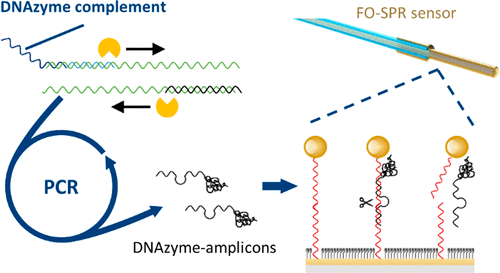当前位置:
X-MOL 学术
›
Anal. Chem.
›
论文详情
Our official English website, www.x-mol.net, welcomes your
feedback! (Note: you will need to create a separate account there.)
Solid-Phase PCR-Amplified DNAzyme Activity for Real-Time FO-SPR Detection of the MCR-2 Gene.
Analytical Chemistry ( IF 6.7 ) Pub Date : 2020-07-08 , DOI: 10.1021/acs.analchem.0c02241 Bernd Peeters 1 , Saba Safdar 1 , Devin Daems 1 , Peter Goos 2 , Dragana Spasic 1 , Jeroen Lammertyn 1
Analytical Chemistry ( IF 6.7 ) Pub Date : 2020-07-08 , DOI: 10.1021/acs.analchem.0c02241 Bernd Peeters 1 , Saba Safdar 1 , Devin Daems 1 , Peter Goos 2 , Dragana Spasic 1 , Jeroen Lammertyn 1
Affiliation

|
The polymerase chain reaction (PCR) has been the gold standard molecular analysis technique for decades and has seen quite some evolution in terms of reaction components, methodology, and readout mechanisms. Nucleic acid enzymes (NAzymes) have been used to further exploit the applications of PCR, but so far the work was limited to the colorimetric G-quadruplex or fluorescent substrate cleaving NAzymes. In this study, a solid-phase, fiber optic surface plasmon resonance (FO-SPR) technique is presented as an alternative readout for PCR utilizing NAzymes. First, the surface cleavage activity of DNAzyme-extended amplicons (DNAzyme-amps) is established, followed by optimization of the PCR conditions, which are required for compatibility with the FO-SPR system. Next, by integrating the complement of a 10–23 DNAzyme into the primer pair, PCR-amplified DNAzyme-amps were generated, tested, and validated on qPCR for the detection of the antimicrobial resistance gene MCR-2. Once validated, this primer concept was developed as a one-step assay, driven by PCR-amplified DNAzymes, for FO-SPR-based sensitive and specific detection. Using gold nanoparticle labeled RNA-DNA hybrid strands as substrate for the DNAzyme, PCR-amplified DNAzyme-amps generated in the presence of MCR-2 gene were monitored in real-time, which resulted in an experimental limit of detection of 4 × 105 copy numbers or 6.6 fM. In addition, the DNAzyme-based FO-PCR assay was able to discriminate between the MCR-1 and MCR-2 genes, to further prove the specificity of this assay. Henceforth, this DNAzyme-based fiber optic PCR assay provides a universally applicable, real-time system for the detection of virtually any target NA, in a specific and sensitive manner.
中文翻译:

固相PCR扩增的DNAzyme活性,用于MCR-2基因的实时FO-SPR检测。
数十年来,聚合酶链反应(PCR)一直是金标准分子分析技术,并且在反应成分,方法学和读出机制方面已有相当大的发展。核酸酶(NAzymes)已被用于进一步开发PCR的应用,但到目前为止,这项工作仅限于比色G-四链体或荧光底物裂解NAzymes。在这项研究中,提出了一种固相,光纤表面等离振子共振(FO-SPR)技术,作为利用NAzymes进行PCR的替代方法。首先,确定了DNA酶扩展的扩增子(DNAzyme-amps)的表面裂解活性,然后优化了与FO-SPR系统兼容所需的PCR条件。接下来,通过将10–23 DNAzyme的互补序列整合到引物对中,在qPCR上生成,测试并验证了PCR扩增的DNAzyme-amps,以检测抗菌素耐药基因MCR-2。一旦得到验证,此引物概念便可以作为一步法开发,由PCR扩增的DNA酶驱动,用于基于FO-SPR的灵敏和特异检测。使用金纳米颗粒标记的RNA-DNA杂合链作为DNAzyme的底物,对存在MCR-2基因的PCR扩增的DNAzyme-amps进行实时监测,导致实验检测限为4×105个复印号码或6.6 fM。此外,基于DNAzyme的FO-PCR测定法能够区分MCR-1和MCR-2基因,以进一步证明该测定法的特异性。此后,这种基于DNAzyme的光纤PCR分析提供了一种普遍适用的实时系统,以特定且灵敏的方式检测几乎所有目标NA。
更新日期:2020-08-04
中文翻译:

固相PCR扩增的DNAzyme活性,用于MCR-2基因的实时FO-SPR检测。
数十年来,聚合酶链反应(PCR)一直是金标准分子分析技术,并且在反应成分,方法学和读出机制方面已有相当大的发展。核酸酶(NAzymes)已被用于进一步开发PCR的应用,但到目前为止,这项工作仅限于比色G-四链体或荧光底物裂解NAzymes。在这项研究中,提出了一种固相,光纤表面等离振子共振(FO-SPR)技术,作为利用NAzymes进行PCR的替代方法。首先,确定了DNA酶扩展的扩增子(DNAzyme-amps)的表面裂解活性,然后优化了与FO-SPR系统兼容所需的PCR条件。接下来,通过将10–23 DNAzyme的互补序列整合到引物对中,在qPCR上生成,测试并验证了PCR扩增的DNAzyme-amps,以检测抗菌素耐药基因MCR-2。一旦得到验证,此引物概念便可以作为一步法开发,由PCR扩增的DNA酶驱动,用于基于FO-SPR的灵敏和特异检测。使用金纳米颗粒标记的RNA-DNA杂合链作为DNAzyme的底物,对存在MCR-2基因的PCR扩增的DNAzyme-amps进行实时监测,导致实验检测限为4×105个复印号码或6.6 fM。此外,基于DNAzyme的FO-PCR测定法能够区分MCR-1和MCR-2基因,以进一步证明该测定法的特异性。此后,这种基于DNAzyme的光纤PCR分析提供了一种普遍适用的实时系统,以特定且灵敏的方式检测几乎所有目标NA。









































 京公网安备 11010802027423号
京公网安备 11010802027423号